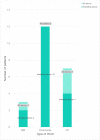Healthcare-associated bacterial infections in the paediatric ICU
- PMID: 34223023
- PMCID: PMC8210264
- DOI: 10.1093/jacamr/dlaa066
Healthcare-associated bacterial infections in the paediatric ICU
Abstract
Background: An estimated 3.2 million patients annually develop healthcare-associated infections (HCAIs) in Europe alone amid the major challenge of increasing antimicrobial resistance. Critically ill children warrant specific evaluation because of differences in epidemiology, causative organisms and infection sites.
Objectives: To examine the prevalence and antimicrobial susceptibility patterns of three types of HCAI in critically ill children and determine the effect on their disease course.
Materials and methods: Retrospective cohort review of critically ill children admitted to a general paediatric ICU (PICU) at a regional academic tertiary referral centre over a 3 year period.
Results: There were 1930 admissions with a median age of 38 months. Children with HCAIs had a higher incidence of comorbidities (74% versus 24%) and a longer median length of stay (8 days versus 3 days). We identified 26 positive isolates (blood, lower respiratory and urine) taken 48 h or more after admission. The combined incidence was 1.34%. Hospital-acquired pneumonia accounted for 58% of HCAIs, urinary tract infections for 31% and bloodstream infections for 11%. The majority (61.5%) of HCAIs were caused by Gram-negative organisms. Seven isolates were resistant to antimicrobials used to treat HCAI. All of these were Gram-negative organisms (Pseudomonas aeruginosa, Klebsiella oxytoca and Escherichia coli).
Conclusions: These data revealed a low incidence of HCAIs, 27% of which were resistant Gram-negative organisms. Critically ill children with HCAIs were more likely to have comorbidities and an increased length of stay. These factors may increasingly impact on PICU bed availability, an already limited resource.
© The Author(s) 2020. Published by Oxford University Press on behalf of the British Society for Antimicrobial Chemotherapy.
Figures
References
-
- Zarb P, Coignard B, Griskeviciene J et al. The European Centre for Disease Prevention and Control (ECDC) pilot point prevalence survey of healthcare-associated infections and antimicrobial use. Euro Surveill 2012; 17: 1–7.. - PubMed
-
- WHO. Health Care-Associated Infections Fact Sheet. 2017. https://www.who.int/gpsc/country_work/gpsc_ccisc_fact_sheet_en.pdf?ua=1.
-
- Sykes SR. The 2009 Garrod Lecture: The evolution of antimicrobial resistance: a Darwinian perspective. J Antimicrob Chemother 2010; 65: 1842–52. - PubMed
-
- Tenover FC. Mechanisms of antimicrobial resistance in bacteria. Am J Infect Control 2006; 34: S1–10. - PubMed
-
- Richards MJ, Edwards JR, Culver DH et al. Nosocomial infections in pediatric intensive care units in the United States. National Nosocomial Surveillance System. Pediatrics 1999; 103: 39. - PubMed
LinkOut - more resources
Full Text Sources



